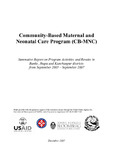Please use this identifier to cite or link to this item:
https://hdl.handle.net/20.500.14356/804| Title: | Community-Based Maternal and Neonatal Care Program (CB-MNC) |
| Authors: | USAID NFHP Johns Hoplings Bloomberg School of Public Health Government of Nepal |
| Issue Date: | 2007 |
| Publisher: | USAID |
| Abstract: | Executive Summary: 1.1 Background: Current statistics show that, despite improvements over the past two decades, the health status of mothers and newborns in Nepal remains low. The maternal mortality ratio in Nepal was estimated to be 281 deaths per 100,000 live births in 2006, a decrease from the previous estimate of 539 in 1996. Major causes of maternal death in Nepal include postpartum hemorrhage (PPH), obstructed labor, eclampsia, and puerperal sepsis. Eighty-one percent of births in Nepal take place at home while skilled birth attendants (SBA: defined as a doctor, nurse, or midwife) are present at only 19 percent of all births. The neonatal death rate was estimated to be 33 deaths per 1,000 live births in 2006—a decrease from 39 deaths per 1,000 live births as measured in 2001. Over the past two decades, due to rapidly falling infant and under-5 mortality rates, the relative proportion of neonatal deaths among all infant and under-5 deaths has risen to 66 percent and 54 percent, respectively. Studies of hospital and community-based mortality data suggest that the major causes of neonatal death in Nepal include preterm birth, infection, hypothermia, and birth asphyxia. Many maternal and newborn deaths can be averted through changes in household-level practices regarding delivery and newborn care. |
| URI: | http://103.69.126.140:8080/handle/20.500.14356/804 |
| Appears in Collections: | Post Graduate Grant (PG) Reports |
Files in This Item:
| File | Description | Size | Format | |
|---|---|---|---|---|
| 517AA.pdf | Full Text. Download | 768.1 kB | Adobe PDF |  View/Open |
Items in DSpace are protected by copyright, with all rights reserved, unless otherwise indicated.
